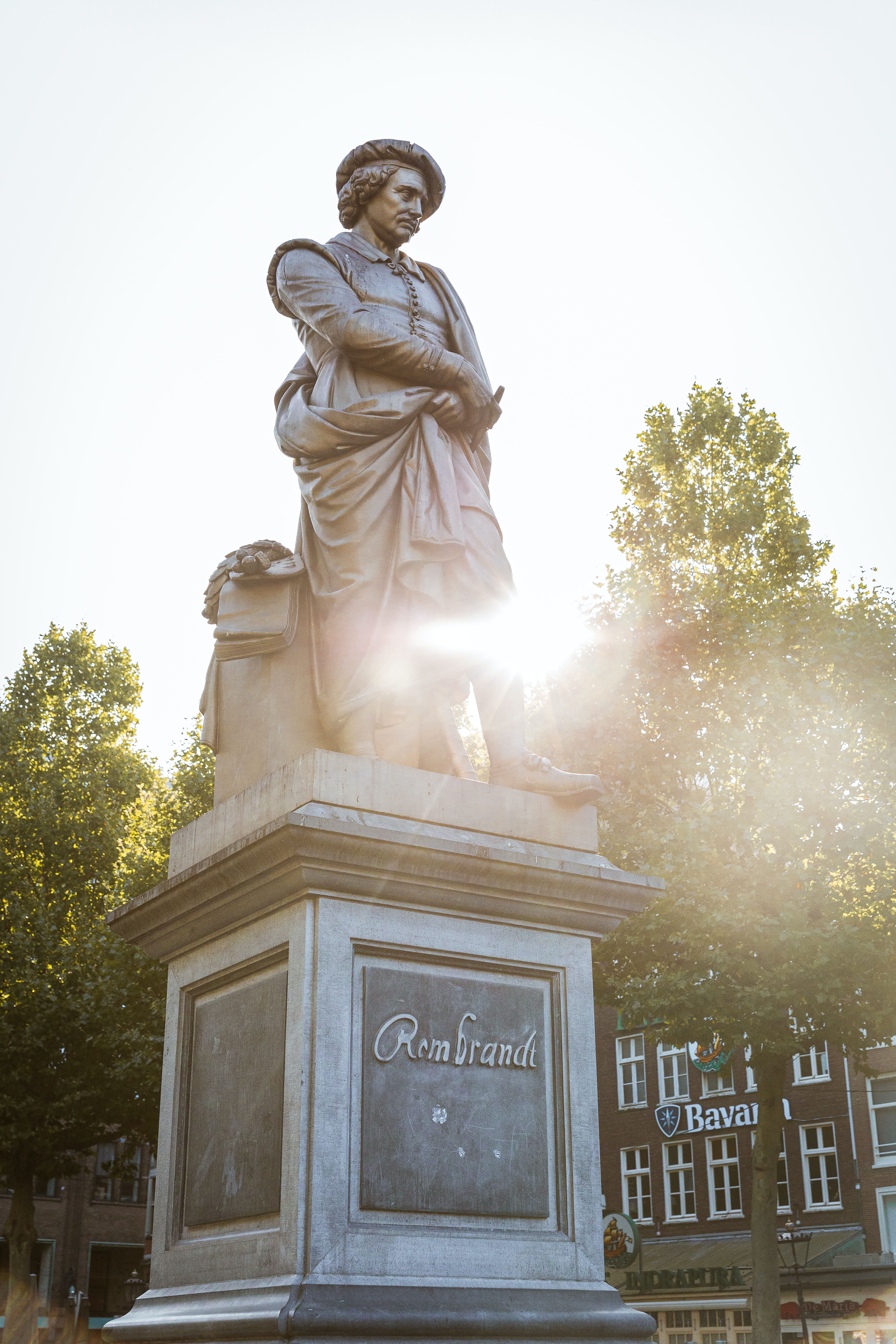Curiosity, Dots & Action: Lessons from Rembrandt

Image is from pexels.com by Nguyen Huynh
Try to put well in practice what you already know; and in so doing, you will in good time, discover the hidden things which you now inquire about. Practice what you know, and it will help to make clear what now you do not know.” - Rembrandt
In the summer of 1618, in a small town of Leiden in the Netherlands, a young curious 12-year-old boy was running around a mill where his father worked, amazed at how the giant wooden blades spun around. As he watched the blades, he would lie down and wonder about the world, watching the sunrise on the east and set on the west. Everything seems to spin around and round. One day, a strong gust of wind causes one of the blades to wobble and become unhinged, putting the entire mill in danger. The young boy, as he was on the ground soaking in the sun and the spinning blades, notices this before anyone else. Being quick-thinking and resourceful, he climbs to the top of the mill and figures out some basic mechanics to repair the blade. His father and the community soon hear about this, and this young lad learns the importance of not only observing the world as it spins around but also being ready to jump into action when called up. Curiosity was not just an act of reflection but had to lead to action to “make this world a better place.”
This young boy’s name was Rembrandt. His curiosity as a child would take him on numerous adventures, which would shape him as an adult and be the spark for the work that he was to do. In the early 1600s, the Netherlands experienced a "tulip mania", in which the price of tulip bulbs skyrocketed. In the town of Leiden, Rembrandt's father and many of the workers in the mill become caught up in the tulip craze, investing their earnings and savings heavily in bulbs and neglecting their mill. However, as the craze subsides, and prices start to nosedive, the family struggles to sell these numerous tulips accumulated. Rembrandt had always wanted to leave Leiden and go to the “greener pastures of Amsterdam”, yet was trying so hard to find a way to help his family out.
Rembrandt, eager to help his family, hatches a plan to sell some of the tulip bulbs in Amsterdam. He heads over and works days and days to try to pawn off these tulips. Yet, there are no takers. A wealthy merchant in Amsterdam, sees this dejected youth, and starts a conversation with him. At this time, Rembrandt has learnt to love tulips. He shares his story but in the process amazes this wealthy man about the beauty of tulips and the power it yields. The merchant not only buys all the tulips but also begins to take an interest in this young man. Even at an early age, Rembrandt’s life is shaped by lessons about the beauty of tulips and the power of money and greed, inspiring him to later paint still paintings of tulips and other objects.

Looking at this picture of tulips, you can almost feel the warmth of the sun on your skin I Image source
Curiosity coupled with action is a powerful tool for success. Yet, there is one more element needed for success. Rembrandt was able to make actionable his curiosity because he translated his curiosity from little dots into a connected chain of insights. These insights enabled him to act.
Be Guided By Our Own Understanding of the Dots
If art is an expression of the artist’s reality, there are few who matched the realism of one Dutch master who sought to reflect life in all its perfect imperfections. Rembrant Harmenszoon van Rijn – known to the world simply as ‘Rembrandt’ – was an artist during the Dutch Golden Age during the 17th Century. Rembrandt (1606-1669) was the second youngest of 10 siblings born into a low middle class-family where, despite the obvious struggles that come with raising such a large family, his parents were able to provide him with a classical education.
Despite his education, Rembrandt showed little interest in painting anything other than the ordinariness of life – an approach which made him stand out against the more flamboyant artists of his time. The Dutch master is one of the most revered painters of all time, due to his incredible works depicting biblical scenes and his many self-portraits. He was also renowned for his innovative and extensive use of shadow and light in his works, which lend them an intriguing and mysterious depth, as can be seen in Judas Repentant, Returning the Pieces of Silver.
Many believe that his biggest influence was Rembrandt's mother, Neeltgen Willemsdr van Zuytbrouck. She was an accomplished painter, yet, very little of her works have survived. Legend has it that young Rembrandt used to watch his mother paint and ask her questions as she painted. His mother would inspire him never to do as others do, but to find his own path and his own style. Much like Emy Thiran, who teaches her art students to “find their own style and be themselves” as they paint, never trying to be a Dali or anyone else, Neeltgen taught Rembrandt the value of being yourself in your work.
This moulded Rembrandt to become an artist who refused to “follow the crowd” when it was fashionable to do so in the art world at that point in time. He received disapprovals of his work because they were often commonplace expressions of life, with some critics suggesting he preferred ugliness to beauty. Depending on who was asked, Rembrandt was either a vulgar artist out for his own gain, or a misunderstood genius who was well ahead of his time. What’s certain about the Dutch master is that he always followed his own way, shunning contemporary ideals of what an artist should be, preferring instead to be an artist authentic to himself.

Rembrandt's mother, Neeltgen Willemsdr van Zuytbrouck I Rembrandt, Public domain, via Wikimedia Commons
As in leadership, maverick artists are often criticised for following their own path. Eleanor Roosevelt once advised that we should, “do what you feel in your heart to be right, for you’ll be criticised anyway.” As Rembrandt’s life shows, those who stand out and build their legacy from innovation are the ones who set the standards for themselves. But these standards are set because there is clarity of where we want to go. Rembrandt saw various dots forming from his curiosity and started connecting these dots. As these dots started to make more and more sense, he had clarity on where he was going and what he was doing, enabling him to have the confidence to go forward in his chosen path and not “copy” others blindly.
Everyone Has A Story
While Rembrandt’s mother had a significant influence in his life, his other childhood experiences moulded him equally. In the Netherlands in the 17th century, gypsies were common across the land. The term "gypsy" was used to describe a group of people who were believed to have originated from the eastern regions of Europe and Asia. These people were often nomadic pilgrims and travelled in small groups or caravans, living off of the land and engaging in various trades and crafts. They were also known for their distinctive culture, which included their own language, music, and customs. In the Netherlands during the 17th century, gypsies were often viewed with suspicion and mistrust by the wider society. They were sometimes accused of engaging in criminal activities such as theft and fraud and were often subjected to discrimination and persecution.
Although little is known about Rembrandt’s childhood, he and his family must have encountered these gypsies at some point in their small town of Leiden, as they were commonplace in that era. Rembrandt would have been fascinated by their colourful clothes and lively music and would have spent hours listening to their stories and watching them dance around the campfire. Their stories of travel from town to town across Europe, with their unique culture and experiences would have enabled Rembrandt to see the world in a new light. Much of his works was in seeing the beauty in everyday objects and people, capturing these moments in his paintings. His unique and new techniques and styles, incorporating the vibrant colours and texture, could only have been possible when he translated his insights from the various things he observed into his paintings, making him stand-out and becoming unique. His paintings, such as The Night Watch, Self-Portrait with Two Circles, and The Anatomy Lesson of Dr. Nicolaes Tulp, are known for their dramatic use of light and shadow, emotional depth, and expressive brushwork, which were very likely inspired by the various insights he captured from the diversity of people and experiences he saw.
Rembrandt's childhood experiences also instilled in him a deep sense of empathy and understanding. He saw the struggles and hardships of his parents, the travelling gypsies across the Netherlands, and the community in Leiden and realised that everyone, regardless of their background or status, had a story to tell. This understanding is evident in his paintings, which often depict ordinary people in everyday situations, showing the beauty and dignity in even the most mundane moments.
Rembrandt learnt the importance of empathy early in life. Throughout his career, Rembrandt was known for his ability to capture the emotional depth and humanity of his subjects, whether they were biblical figures or ordinary people. He was able to connect with his sitters on a personal level, gaining their trust and understanding their perspectives.
This skill was particularly evident in Rembrandt's many self-portraits, which offer a glimpse into his own psyche and emotional state. In these works, he portrays himself not as a distant and unapproachable artist but as a vulnerable and flawed human being, struggling with the same doubts and fears as anyone else. This willingness to show vulnerability and connect with others on a human level is a valuable trait for leaders, as it helps to build trust and foster meaningful relationships.
Self-Awareness & Growth
Rembrandt left his unique mark on everything in his life, even his name. Given the birth name “Rembrant”, he later added the ‘d’ to his signature in 1633, although it’s still debated why he made the change. Perhaps it could be argued that Rembrandt was the pioneer of personal branding. Given his mastery over the use of shadow and light, it could certainly be the case that he wanted to connect his name to his work, both symbolically and literally. The word Rem in Dutch means ‘to clog’ or ‘dim’, while the word Brandt means ‘to burn’ or ‘light’.
This attention to detail is seen throughout his life as a focal point of his continual self-examination and exploration. Rembrandt painted between 80-90 self-portraits and, through time, he represents his changes and imperfections that we all find in our human condition. For Rembrandt, part of self-actualisation was to know and embrace his flaws and limitations, rather than to avoid or suppress them.
As leaders, we talk a lot about the importance of self-reflection and self-examination. Of course, we grow in confidence when we reflect on what we’ve done well and the achievements we’ve made. But we grow when we look for the areas that leave room for improvement. The greatest leaders are those who can be honest with themselves with regard to their personal limitations, working on them where it’s possible, and accepting them as being part of who they are as they progress in their development.
Self-awareness can enable us to adapt and persevere in the face of adversity. Throughout his career, Rembrandt faced numerous setbacks, including financial difficulties, personal losses (he lost his wife and three of his children) and declining popularity. Despite these challenges, his passion for art did not diminish and he continued to experiment with new techniques and styles, adapting to the changing art market.
For example, during the early years of his career, Rembrandt focused on traditional subjects such as biblical scenes and portraits. However, as the popularity of those works declined, he began to explore new themes, such as landscapes and genre scenes, which were more appealing to the emerging middle-class market. Similarly, he experimented with different styles, moving away from the precise and polished techniques of his early works, and embracing a looser and more expressive approach.
Rembrandt’s most famous work, The Night Watch (1642), depicts a militia company – a group of men who could be called into service to defend the city or put a stop to riots. Showing an ‘ordinary’ scene, what makes the painting so striking is its composition and the emotion that can be seen in the faces of the figures – it’s almost like a photograph of the time.
However, the painting, which was commissioned in 1640 was met with criticism and controversy when it was unveiled. The subjects were not depicted in a traditional pose, and the composition was seen as too chaotic and unstructured. As a result, Rembrandt was forced to make changes to the painting, cutting it down in size and altering the composition. Despite this setback, he continued to work on the painting, adding new details and layers of meaning over the years, until it was the final masterpiece.
Innovation is a result of curiosity, coupled with understanding the “context of the time” and taking those insights to build and ship a product accordingly. And constantly changing and refreshing our approach to our work. Rembrandt kept fixing The Night Watch until it became what it is today.
Why Leaders Need to End Well
In the years that followed Rembrandt’s iconic painting, he produced fewer and fewer works. Although many myths surround the life of the Dutch master, art scholars suggest the reason for the diminished work-rate was down to the limits of Rembrandt’s artistic expression being stretched to their limits and his declining sense of curiosity as he grew older. Traumas and tragedies in his personal life probably affected the artist a great deal as it does to many of us. Many leaders start well but end badly.
Although his fame and renown were never in doubt, Rembrandt sadly died a poor man in 1669, mostly due to his tendency to live beyond his means. Buried in an unknown grave, his remains were later destroyed, as was the custom with poor people at the time. Perhaps as a final lesson, Rembrandt’s life teaches us to push our potential single-mindedly, but to manage our resources wisely and never take what we have for granted.
And as he aged, Rembrandt lost his “curiosity with action.” Many of us are able to get to a point of success, but to remain at the cutting edge, we need to constantly grow. As Rembrandt stopped growing, his ability to “see the world” through the lens of curiosity and take action on his insights, diminished. We must never lose our curiosity of the world. We need to constantly be observing new dots as they emerge. In our new world, the new dots of blockchain, Internet of Things (IOT), robotics, pandemics, and so many other “dots” that have emerged need to be viewed in the lens of curiosity as Rembrandt did. But more importantly, knowing and having these insights is just the starting point. Rembrandt’s success was due to being able to “connect the dots” and take action. All through his life, as he “connected the dots” and took action on these insights, he succeeded beyond his wildest imagination. As he stopped seeing these “dots” and stopped gaining new insights, he was not able to innovate and bring great new work.
We can learn from Rembrandt and push ourselves to never stop growing. To keep being curious about the world around us, and to keep connecting dots and taking action on these dots. If we do that till our last breath, we will start well and end well too.
Author's Note: Some of the stories in this article on Rembrandt's childhood have been created based on historical events at the time of Rembrandt's youth (ie Tulip craze in the Netherlands in the 17th century) and also based on actual facts (i.e his father did work at a mill and his mother was an accomplished painter). However, we cannot know for certain if the stories did take place as prescribed.
This may interest you: Curiosity At Work: 5 Opportunities to Show Up A Bit More Curious
Did you know…?
Although Rembrandt painted many self-portraits, he also painted himself into several of his other works including The Stoning of St. Stephen and Raising of the Cross.
Leaderonomics.com is an advertisement free website. Your continuous support and trust in us allows us to curate, deliver and upkeep the maintenance of our website. When you support us, you allow millions to continue reading for free on our website. Will you give today? Click here to support us.
Leadership
Tags: Self Leadership, Self-Agency, Self Identity, Vision, Creativity, Performance Character
Roshan is the Founder and “Kuli” of the Leaderonomics Group of companies. He believes that everyone can be a leader and "make a dent in the universe," in their own special ways. He is featured on TV, radio and numerous publications sharing the Science of Building Leaders and on leadership development. Follow him at www.roshanthiran.com





